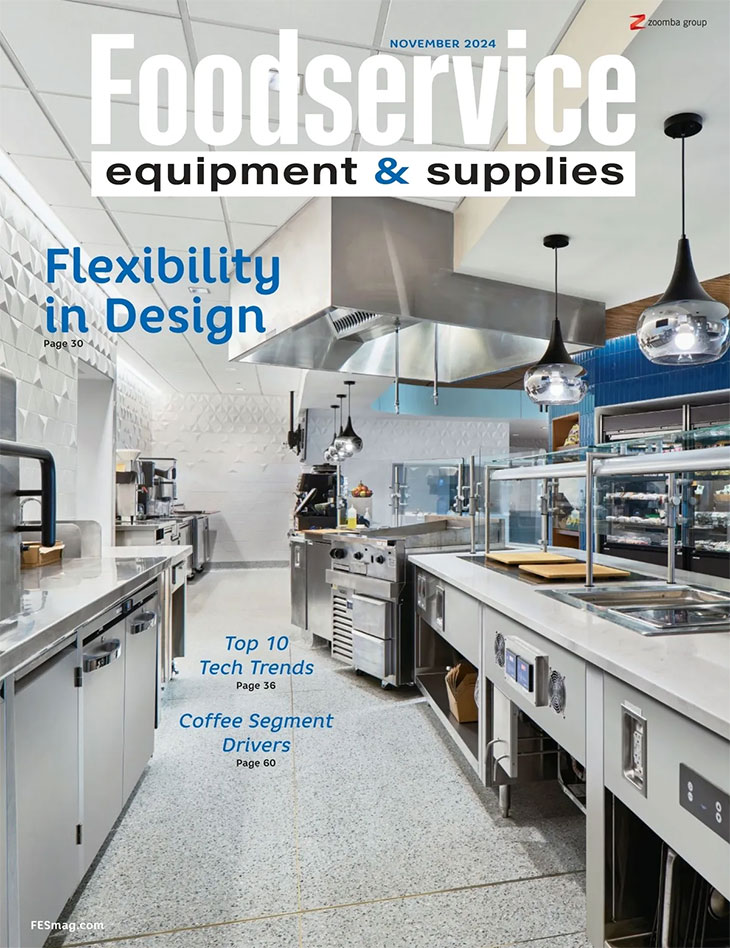Fire-suppression equipment for use in commercial foodservice operations is classified as UL 300, which ensures it meets the necessary guidelines and standards. These systems utilize wet chemicals and ventilation control to extinguish flames.
 There are different system types. Appliance-specific designs have dedicated nozzles for each appliance, depending on the level of protection required. For example, a range would have different coverage than a fryer. Another type is overlapping or full flood protection systems, spaced equally throughout the hood and designed to cover most appliances, although there are exceptions. For example, equipment, such as back-shelf salamanders, requires an appliance-specific drop-in addition to these systems. From an applications standpoint, appliance-specific systems cost less because they use fewer drops or fire-retarding agents and tanks.
There are different system types. Appliance-specific designs have dedicated nozzles for each appliance, depending on the level of protection required. For example, a range would have different coverage than a fryer. Another type is overlapping or full flood protection systems, spaced equally throughout the hood and designed to cover most appliances, although there are exceptions. For example, equipment, such as back-shelf salamanders, requires an appliance-specific drop-in addition to these systems. From an applications standpoint, appliance-specific systems cost less because they use fewer drops or fire-retarding agents and tanks.
Experts recommend utilizing appliance-specific systems when the equipment lineup is not likely to change. For instance, if the fryer and a griddle will always be in the same locations, this setup is ideal. This is also true with equipment lines that overlap, such as back-shelf salamanders. In addition, appliance-specific fire-suppression systems are ideal if the line includes equipment that doesn’t require protection, such as steamers or prep tables situated under the hood beside grease-producing appliances.
Applications for overlapping areas will cost more, but this is where operators will benefit from greater flexibility, such as if equipment is being changed out or moved around. If a fryer is being swapped out for a range, or if a new chef comes in and wants to move appliances around, this type of fire-suppression system will provide consistent protection. Also, if the cook line includes a lot of heavy equipment, an overlapping type is recommended for extra safety. Dual-agent overlapping systems are also available. These utilize chemicals to smother the flames and water backup to cool off the equipment in the event of a fire. There are also water-based systems.
Another consideration of fire-suppression equipment concerns aesthetics. With some systems, the piping is visible as it hangs down below the hood. If this is an issue, overlapping systems have higher proximity piping with nozzles farther away from appliances, which is preferred aesthetically. This type is common for open kitchens that are visible to customers.
There are basically three mounting options for fire-suppression systems. A remote-mounted type has a tank on the wall next to the hood. Another option is a utility cabinet that is mounted at the end of the hood and is more concealed. Finally, there are wall-mounted utility cabinets, which are similar to the cabinet-mounted type but are even more obscured.
It’s important to note that there are a number of regulations in terms of the distance between the fire-suppression equipment and the equipment being covered. Experts generally recommend hood mounting. This is factory installed, so there is no piping from the hood to the tank. It is not only more aesthetically pleasing but is also built into a cabinet that is mounted on the hood.
Tank activation, or how the fire-retarding agent is triggered, can be pressurized, unpressurized or electric. The unpressurized type has agents in the tank, while the pressurized type has an actuation cylinder or nitrogen to pressurize the system. Electric activation uses a combination of an unpressurized system and cartridges.
The tank size needed depends on the application. Manufacturers offer a variety of options, including ?½, ?¾, 3, 3¾ and 4¾ gallons.
The standard detection system utilizes fusible links, which are comprised of two pieces of metal with a different type of metal in between that melds them together. When the middle piece is melted by heat or fire, the pieces separate, activating the fire-suppression system. Another type utilizes pneumatic tubing with a pressurized tube that, when melted, activates the system.
Electric detection is the newest technology with fire-suppression equipment. This works either linearly by measuring the temperature inside the ventilation hood or by utilizing spot detection, which has a sensor in one spot. Some electrical detection systems include full supervision of the fire system using fire lines and nitrogen cartridges. These detection techniques also inform operators if the system isn’t working or needs service.
Fire-suppression systems can tie into other equipment through gas valves or electrical hookups in order to automatically shut off fuel or power in case of a fire. With gas appliances, the hookup is dependent on the size of the gas feed, while with electrical equipment, signals are sent to shut off the breakers.
Fire-suppression equipment also needs to interface with kitchen control systems or fire alarms to alert those in the facility of a fire. This also shuts down the equipment, activates the exhaust fan and alerts the local fire station.











